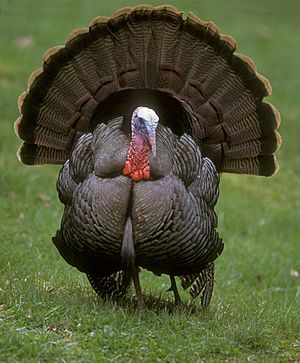Galliformes facts for kids
Quick facts for kids Galliformes |
|
|---|---|
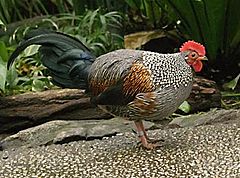 |
|
| Male Grey Junglefowl, Gallus sonneratii | |
| Scientific classification | |
| Kingdom: | |
| Phylum: | |
| Class: | |
| Order: |
Galliformes
Temminck, 1820
|
| Families | |
Galliformes are an order of birds containing turkeys, grouse, chickens, quails, and pheasants. More than 250 living species are found worldwide. Usually, birds belonging to Galliformes order have 4 toes. Three long toes in the front to dig and scratch and one short toe behind.
Contents
Description
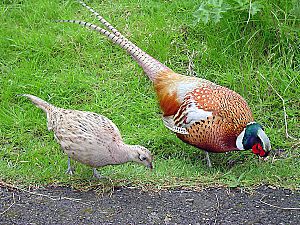
They are chicken-like in appearance, with rounded bodies and blunt wings, and range in size from small at 15 cm (6 inches) to large at 120 cm (4 feet). They are mainly terrestrial birds and their wings are short and rounded for short-distance flight. Galiforms are anisodactyly like passerines, but some of the adult males grow spurs that points backward.
Gallinaceous birds are arboreal or terrestrial animals; many prefer not to fly, but instead walk and run for locomotion. They live 5–8 years in the wild and up to 30 years in captivity. They can be found worldwide and in a variety of habitats, including forests, deserts, and grasslands. They use visual displays and vocalizations for communication, courtship, fighting, territoriality, and brooding.
They have diverse mating strategies: some are monogamous, while others are polygamous or polygynandrous. Male courtship behavior includes elaborate visual displays of plumage. They breed seasonally in accordance with the climate and lay three to 16 eggs per year in nests built on the ground or in trees.
Gallinaceous birds feed on a variety of plant and animal material, which may include fruits, seeds, leaves, shoots, flowers, tubers, roots, insects, snails, worms, lizards, snakes, small rodents, and eggs.
These birds vary in size from the diminutive king quail (Coturnix chinensis) (5 in) long and weighing 28–40 g (1–1.4 oz) to the largest extant galliform species, the North American wild turkey (Meleagris gallopavo), which may weigh as much as 14 kg (30.5 lb) and may exceed 120 cm (47 in).
The galliform bird species with the largest wingspan and largest overall length (including a train of over 6 feet) is most likely the green peafowl (Pavo muticus). Most galliform genera are plump-bodied with thick necks and moderately long legs, with rounded and rather short wings. Grouse, pheasants, francolins, and partridges are typical in their outwardly corpulent silhouettes.
Adult males of many galliform birds have one to several sharp horny spurs on the back of each leg, which they use for fighting. In several lineages, pronounced sexual dimorphism occurs, and among each galliform clade, the more apomorphic ("advanced") lineages tend to be more sexually dimorphic.
Flightlessness
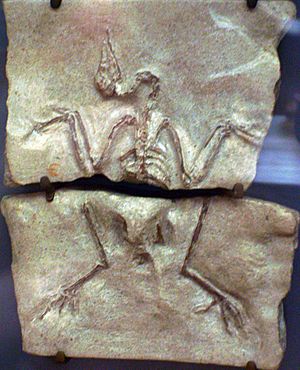
While most galliformes are rather reluctant flyers, flightless forms are utterly unknown among the living members of the order. Though they are often mischaracterised as weak-flying, Galliformes are actually highly specialised for their particular flight style, bearing extremely powerful flight muscles, and some species are even migratory.
Nonetheless, a few birds outside the Galliforme crown-group did produce flightlessness.
The genus Sylviornis, a huge prehistorically extinct species of New Caledonia, was flightless, but as opposed to most other flightless birds like ratites or island rails which become flightless due to arrested development of their flight apparatus and subsequently evolve to larger size, Sylviornis seems to have become flightless simply due to its bulk, with the wing reduction following a consequence, not the reason for its flightlessness.
The gigantic australian mihirungs, which may be closer to Galliformes than to Anseriformes as traditionally expected, achieved flightlessness more traditionally, strongly reducing their wings and keel. They were massive herbivorous birds, among the largest avian dinosaurs of all time.
Behaviour and ecology
Most of the galliform birds are more or less resident, but some of the smaller temperate species (such as quail) do migrate over considerable distances. Altitudinal migration is evidently quite common amongst montane species, and a few species of subtropical and subarctic regions must reach their watering and/or foraging areas through sustained flight. Species known to make extensive flights include the ptarmigans, sage-grouse (Centrocercus), crested partridge, green peafowl, crested argus, mountain peacock-pheasant (Polyplectron inopinatum), koklass pheasant (Pucrasia macrolopha), Reeves's pheasant and (Syrmaticus reevesii). Other species—most of the New World quails (also known as the toothed quails), the enigmatic stone partridge (Ptilopachus petrosus) of Africa, guineafowl, and eared pheasants (Crossoptilon)—are all notable for their daily excursions on foot which may take them many miles in a given day.
Some Galliformes are adapted to grassland habitat, and these genera are remarkable for their long, thin necks, long legs, and large, wide wings. Fairly unrelated species like the crested fireback (Lophura ignita), vulturine guineafowl (Acryllium vulturinum), and malleefowl (Leipoa ocellata) are outwardly similar in their body types (see also convergent evolution).
Most species that show only limited sexual dimorphism are notable for the great amount of locomotion required to find food throughout the majority of the year. Those species that are highly sedentary but with marked ecological transformations over seasons exhibit marked distinct differences between the sexes in size and/or appearance. Eared-pheasants, guineafowls, toothed quails, and the snow partridge (Lerwa lerwa) are examples of limited sexual differences and requirements for traveling over wide terrain to forage.
The bronze-tailed peacock-pheasant (Polyplectron chalcurum), snow partridge, painted spurfowl (Galloperdix lunulata), and crimson-headed partridge (Haematortyx sanguiniceps) are notable in their habit of moving around as pairs not only on foot, but also in the air.
Winter ecology
Gallinaceous birds are well adapted to regions with cold winters. Their larger size, increased plumage, and lower activity levels help them to withstand the cold and conserve energy. Under such conditions, they are able to change their feeding strategy to that of a ruminant. This allows them to feed on and extract energy and nutrients from coarse, fibrous plant material, such as buds, twigs, and conifer needles. This provides a virtually unlimited source of accessible food and requires little energy to harvest.
Food and feeding
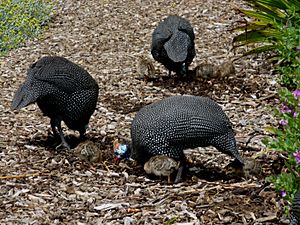
Herbivorous to slightly omnivorous galliforms, comprising the majority of the group, are typically stoutly built and have short, thick bills primarily adapted for foraging on the ground for rootlets or the consumption of other plant material such as heather shoots. The young birds will also take insects.
Peafowl, junglefowl and most of the subtropical pheasant genera have very different nutritional requirements from typical Palearctic genera. The Himalayan monal (Lophophorus impejanus) has been observed digging in the rotting wood of deadfall in a similar manner to woodpeckers to extract invertebrates, even bracing itself with aid of its squared tail. The cheer pheasant (Catreus wallichi), crested argus (Rheinardia ocellata), the crested partridge (Rollulus roulroul) and the crested guineafowl (Guttera pucherani) are similar ecologically to the Himalayan monal in that they too forage in rotting wood for termites, ant and beetle larvae, molluscs, crustaceans and young rodents.
Typical peafowl (Pavo), most of the peacock-pheasants (Polyplectron), the Bulwer's pheasant (Lophura bulweri), the ruffed pheasants (Chrysolophus) and the hill partridges (Arborophila) have narrow, relatively delicate bills, poorly suited for digging. These galliform genera prefer instead to capture live invertebrates in leaf litter, in sand, or shallow pools or along stream banks. These genera are also outwardly similar in that they each have exceptionally long, delicate legs and toes and the tendency to frequent seasonally wet habitats to forage, especially during chick-rearing. The blue peafowl (Pavo cristatus) is famed in its native India for its appetite for snakes – even poisonous cobras – which it dispatches with its strong feet and sharp bill. The Lady Amherst's pheasant (Chrysolophus amherstiae), green peafowl (Pavo muticus), Bulwer's pheasant and the crestless fireback (Lophura erythrophthalma) are notable for their aptitude to forage for crustaceans such as crayfish and other aquatic small animals in shallow streams and amongst rushes in much the same manner as some members of the rail family (Rallidae). Similarly, although wild turkeys (Meleagris gallopavo) have a diet primarily of vegetation, they will eat insects, mice, lizards, and amphibians, wading in water to hunt for the latter. Domestic hens (Gallus domesticus) share this opportunistic behaviour and will eat insects, mice, worms, and amphibians.

The tragopans (Tragopan), mikado pheasant (Syrmaticus mikado), and several species of grouse and ptarmigan are exceptional in their largely vegetarian and arboreal foraging habitats; grouse are especially notable for being able to feed on plants rich in terpenes and quinones – such as sagebrush or conifers –, which are often avoided by other herbivores. Many species of moderate altitudes—for example the long-tailed pheasants of the genus Syrmaticus—also find a great deal of their daily nutritional requirements in the tree canopies, especially during the snowy and rainy periods when foraging on the ground is dangerous and less than fruitful for a variety of reasons. Although members of the genus Syrmaticus are capable of subsisting almost entirely on vegetarian materials for months at a time, this is not true for many of the subtropical genera. For example, the great argus (Argusianus argus) and crested argus may do most of their foraging during rainy months in the canopy of the jungle, as well. There they are known to forage on slugs, snails, ants, and amphibians to the exclusion of plant material. How they forage in the forest canopy during the rainy months is unknown.
Reproduction
Most galliforms are very prolific, with clutches regularly exceeding 10 eggs in many species. In contrast to most birds which are – at least for a particular breeding season – monogamous, galliforms are often polygynous or polygamous.
Galliform young are very precocious and roam with their mothers – or both parents in monogamous species – mere hours after hatching. The most extreme case are the Megapodiidae, where the adults do not brood, but leave incubation to mounds of rotting vegetation, volcanic ash, or hot sand. The young must dig out of the nest mounds after hatching, but they emerge from the eggs fully feathered, and upon leaving the mound, they are able to fly considerable distances.
See also
 In Spanish: Gallináceas para niños
In Spanish: Gallináceas para niños


